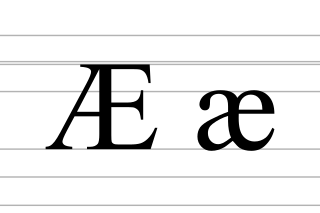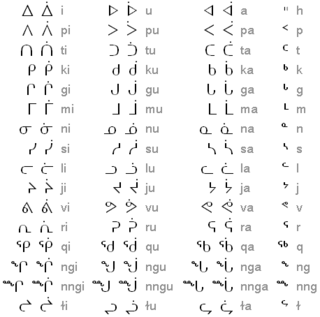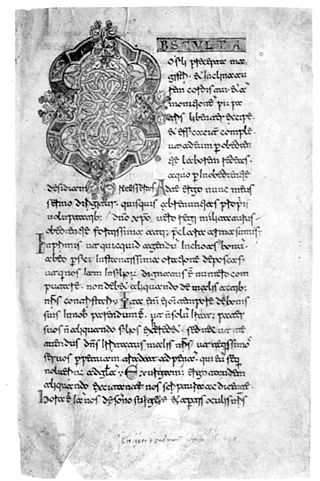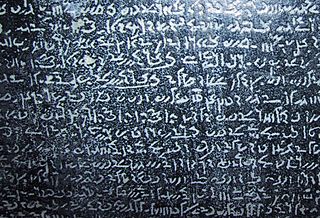This article needs additional citations for verification .(December 2024) |
In grammar, a ligature is a morpheme that links two elements. [1]
This article needs additional citations for verification .(December 2024) |
In grammar, a ligature is a morpheme that links two elements. [1]

The Arabic alphabet, or the Arabic abjad, is the Arabic script as specifically codified for writing the Arabic language. It is written from right-to-left in a cursive style, and includes 28 letters, of which most have contextual letterforms. Unlike the modern Latin alphabet, the script has no concept of letter case. The Arabic alphabet is considered an abjad, with only consonants required to be written; due to its optional use of diacritics to notate vowels, it is considered an impure abjad.
Digamma or wau is an archaic letter of the Greek alphabet. It originally stood for the sound but it has remained in use principally as a Greek numeral for 6. Whereas it was originally called waw or wau, its most common appellation in classical Greek is digamma; as a numeral, it was called episēmon during the Byzantine era and is now known as stigma after the Byzantine ligature combining σ-τ as ϛ.
The ampersand, also known as the and sign, is the logogram &, representing the conjunction "and". It originated as a ligature of the letters of the word et.
Malayalam script is a Brahmic script used commonly to write Malayalam, which is the principal language of Kerala, India, spoken by 45 million people in the world. It is a Dravidian language spoken in the Indian state of Kerala and the union territories of Lakshadweep and Puducherry by the Malayali people. It is one of the official scripts of the Indian Republic. Malayalam script is also widely used for writing Sanskrit texts in Kerala.

Æ is a character formed from the letters a and e, originally a ligature representing the Latin diphthong ae. It has been promoted to the status of a letter in some languages, including Danish, Norwegian, Icelandic, and Faroese. It was also used in Old Swedish before being changed to ä. It was also used in Ossetian before switched back to its Cyrillic counterpart. The modern International Phonetic Alphabet uses it to represent the near-open front unrounded vowel. Diacritic variants include Ǣ/ǣ, Ǽ/ǽ, Æ̀/æ̀, Æ̂/æ̂ and Æ̃/æ̃.

Strangling or strangulation is compression of the neck that may lead to unconsciousness or death by causing an increasingly hypoxic state in the brain by restricting the flow of oxygen through the trachea. Fatal strangulation typically occurs in cases of violence, accidents, and is one of two main ways that hanging causes death.

Inuktitut syllabics is an abugida-type writing system used in Canada by the Inuktitut-speaking Inuit of the territory of Nunavut and the Nunavik and Nunatsiavut regions of Quebec and Labrador, respectively. In 1976, the Language Commission of the Inuit Cultural Institute made it the co-official script for the Inuit languages, along with the Latin script.

In writing and typography, a ligature occurs where two or more graphemes or letters are joined to form a single glyph. Examples are the characters ⟨æ⟩ and ⟨œ⟩ used in English and French, in which the letters ⟨a⟩ and ⟨e⟩ are joined for the first ligature and the letters ⟨o⟩ and ⟨e⟩ are joined for the second ligature. For stylistic and legibility reasons, ⟨f⟩ and ⟨i⟩ are often merged to create ⟨fi⟩ ; the same is true of ⟨s⟩ and ⟨t⟩ to create ⟨st⟩. The common ampersand, ⟨&⟩, developed from a ligature in which the handwritten Latin letters ⟨e⟩ and ⟨t⟩ were combined.
The numero sign or numero symbol, № (also represented as Nº, No̱, №, No., or no.), is a typographic abbreviation of the word number(s) indicating ordinal numeration, especially in names and titles. For example, using the numero sign, the written long-form of the address "Number 29 Acacia Road" is shortened to "№ 29 Acacia Rd", yet both forms are spoken long.

Ł or ł, described in English as L with stroke, is a letter of the Polish, Kashubian, Kurdish, Sorbian, Belarusian Latin, Ukrainian Latin, Wymysorys, Navajo, Dëne Sųłıné, Inupiaq, Zuni, Hupa, Sm'álgyax, Nisga'a, and Dogrib alphabets, several proposed alphabets for the Venetian language, and the ISO 11940 romanization of the Thai script. In some Slavic languages, it represents the continuation of the Proto-Slavic non-palatal ⟨L⟩, except in Polish, Kashubian, and Sorbian, where it evolved further into. In most non-European languages, it represents a voiceless alveolar lateral fricative or similar sound.

The Beneventan script was a medieval script that originated in the Duchy of Benevento in southern Italy. In the past it has also been called Langobarda, Longobarda, Longobardisca, or sometimes Gothica; it was first called Beneventan by palaeographer E. A. Lowe.

Ou is a ligature of the Greek letters ο and υ which was frequently used in Byzantine manuscripts. This omicron-upsilon ligature is still seen today on icon artwork in Greek Orthodox churches, and sometimes in graffiti or other forms of informal or decorative writing.

Demotic is the ancient Egyptian script derived from northern forms of hieratic used in the Nile Delta. The term was first used by the Greek historian Herodotus to distinguish it from hieratic and hieroglyphic scripts. By convention, the word "Demotic" is capitalized in order to distinguish it from demotic Greek.
The Kom language is the language spoken by the Kom people in Northwest Province in Cameroon. It is classified as a Central Ring language of the Grassfields, Southern Bantoid languages in the Niger-Congo language family. Kom is a tonal language with three tones.
The Miskito language, the language of the Miskito people of the Atlantic coast of Nicaragua and Honduras, is a member of the Misumalpan language family and also a strongly Germanic-influenced language. Miskito is as widely spoken in Honduras and Nicaragua as Spanish, it is also an official language in the Atlantic region of these countries. With more than 8 million speakers, Miskito has positioned in the second place in both countries after Spanish. Miskito is not only spoken in Central America, but in Europe, the USA, Canada and in many other Latin American countries. Miskito used to be a royal state language in the 16th to 19th dynasties of the Miskito Kingdom.
Many scripts in Unicode, such as Arabic, have special orthographic rules that require certain combinations of letterforms to be combined into special ligature forms. In English, the common ampersand (&) developed from a ligature in which the handwritten Latin letters e and t were combined. The rules governing ligature formation in Arabic can be quite complex, requiring special script-shaping technologies such as the Arabic Calligraphic Engine by Thomas Milo's DecoType.

Florian Ungler and Kasper Hochfeder were printers from Bavaria that after 1510 became pioneers of printing and publishing in the Polish language.

The Armenian alphabet or, more broadly, the Armenian script, is an alphabetic writing system developed for Armenian and occasionally used to write other languages. It was developed around 405 CE by Mesrop Mashtots, an Armenian linguist and ecclesiastical leader. The script originally had 36 letters. Eventually, two more were adopted in the 13th century. In reformed Armenian orthography (1920s), the ligature ևev is also treated as a letter, bringing the total number of letters to 39.

The dagger alif or superscript alif is written as a short vertical stroke on top of an Arabic letter. It indicates a long sound where alif is normally not written, e.g. هَٰذَا hādhā or رَحْمَٰن raḥmān. The dagger alif occurs in only a few modern words, but these include some common ones; it is seldom written, however, even in fully vocalised texts, except in the Qur'an. As Wright notes "[alif] was at first more rarely marked than the other long vowels, and hence it happens that, at a later period, after the invention of the vowel-points, it was indicated in some very common words merely by a fatḥa [i.e. the dagger alif.]" Most keyboards do not have dagger alif. The word الله is usually produced automatically by entering "alif lām lām hāʾ", or in Arabic: "ا ل ل ه". The word consists of alif + ligature of doubled lām with a shadda and a dagger alif above lām.
Ligature may refer to:
{{cite web}}: |last= has generic name (help)